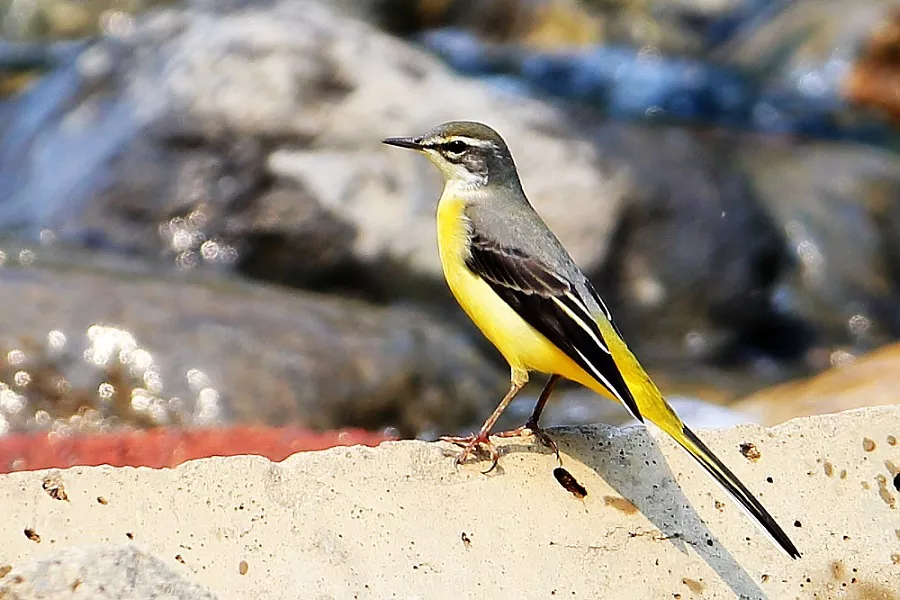The western yellow wagtail (Motacilla flava) is a small passerine in the wagtail family Motacillidae, with a body length of 15-18 cm. The top of the head is blue-gray or dark. The upper body is olive green or gray, with white, yellow or yellow-white eyebrow lines. The flight feathers are dark brown with two white or yellow-white horizontal spots. The tail is dark brown, and the outermost two pairs of tail feathers are mostly white. The lower body is yellow, somewhat similar to Gray Wagtail.
What does a yellow wagtail look like
There are many subspecies of The yellow wagtail in China. Although the plumage color of each subspecies varies to varying degrees, the upper body is mainly olive green or grass green, and some are grayer. The top of the head and the back of the neck are mostly gray, blue-gray, dark gray or green, the forehead is slightly lighter, and the eyebrows are white, yellow or without eyebrows. Some have yellower waists and light-colored feathers on the wing coverts. The tail is long and mainly black, and the outer two pairs of tail feathers are mainly white. The underparts are bright yellow, the chest and sides are sometimes stained with olive green, and the chin is white. The two wings are dark brown, and the middle and large coverts have yellowish-white end spots, forming two wing spots on the wings.
Iris brown, mouth and tarsus black
yellow wagtail size: weight 16-22 grams, body length 15-18cm
Yellow wagtail habitat
The yellow wagtail mainly inhabits low hills, plains, plateaus and mountains above 4,000 meters above sea level. It is often active in forest margins, streams in forests, plain valleys, villages, lakesides and settlements.
Yellow wagtail living habit
They usually come in pairs or small flocks of 3 to 5 individuals, and large flocks of dozens of individuals can also be seen during the migration period. It likes to perch on the riverside or on the stones in the middle of the river, and its tail keeps swinging up and down. Sometimes they walk back and forth along the water’s edge non-stop. When flying, the two wings are retracted and stretched, and they move forward in waves, often singing while flying.
Migration: Migrate to China in early April every spring and October-November in autumn.
Feeding habits: Mainly feed on insects, mostly prey on the ground, sometimes also prey in the air. The food types mainly include ants, gnats, floating dust, and Coleoptera and Lepidoptera insects.
Distribution range of Yellow wagtail
Mainly distributed in China, Russia, northwestern Mongolia, India, France, Italy, Slovenia, Iberia and other places.
Mode of reproduction
The breeding season is from May to July. It usually nests in the grass on rocky slopes by the river and on the edge of Tatou pier in the wet Tatoudian. Occasionally, it can be seen nesting in the firewood piles of residents at the edge of the village. The nest is very well concealed. The nest is bowl-shaped, mainly composed of dry grass stems and leaves, lined with wool, cow hair and bird feathers. The size of the nest is 6-7 cm x 7-8 cm in inner diameter, 9-10 cm x 11-12 cm in outer diameter, 6-7 cm high and 5-6 cm deep. Nesting is shared by both male and female parents, and egg laying begins after the nest is built. The earliest eggs were laid in early May, and most of them started to lay eggs in the middle and late May, with 1 egg per day, 5-6 eggs per clutch, and 5 eggs at most. Eggs are off-white, with brown spots and stripes on them, the size of the eggs is 14-15 mm × 19-21 mm, and the weight is 1.9-2.2 grams.
The hatching is mainly undertaken by the female bird, and the incubation period is 14 days. The chicks are late-born, and when they first hatch, except for a little grayish-yellow down feathers on the top of the head, shoulders and waist, the rest are completely naked and featherless, with their eyes closed and their whole body red. The male and female parents brood together, and there are two feeding peaks every day. Once at 9:00~10:10, feed up to 16 times per hour; once at 16:00~17:00, about 14 times per hour. The chicks stay in the nest for 14±1 days.


 Facebook
Facebook  Instagram
Instagram  Youtube
Youtube 